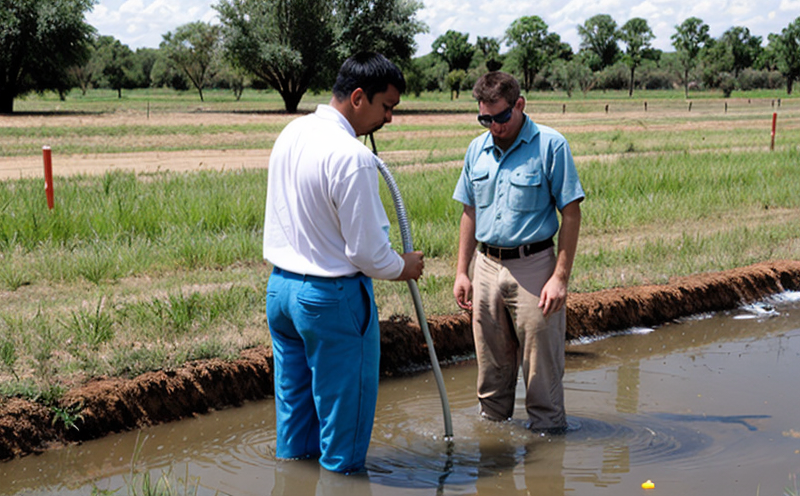ASTM D1293 pH Determination Test in Groundwater
The ASTM D1293 standard provides a comprehensive method for determining the pH of various fluids, including groundwater. This test is crucial for environmental monitoring and compliance with international standards such as ISO 17025. The primary goal of this service is to ensure accurate measurement of pH levels in groundwater samples to assess water quality.
The importance of this test cannot be overstated, especially considering the impact on public health and ecological balance. Groundwater is a vital resource that supports ecosystems, agriculture, and drinking water supplies. Variations in pH can lead to significant changes in the chemical composition of groundwater, affecting its usability and environmental integrity.
The ASTM D1293 method involves several key steps, including sample collection, preparation, and analysis using a pH meter calibrated according to ISO 7027:1984. The test aims to provide reliable results that comply with the strictest global standards. This ensures that decision-makers have accurate data for environmental management, regulatory compliance, and risk assessment.
The accuracy of pH measurement is critical in groundwater testing. Variations in pH can indicate contamination from industrial or agricultural sources, natural processes such as rock weathering, or human activities like improper waste disposal. By adhering to ASTM D1293, laboratories ensure that their results are consistent and comparable across different locations and over time.
Our service offers a robust framework for conducting this test, leveraging advanced analytical techniques and experienced personnel to deliver precise pH values. We employ state-of-the-art equipment and follow stringent quality control procedures to meet the highest standards of accuracy and reliability.
| Key Parameters | Description |
|---|---|
| pH Measurement Range | 0–14 with a precision of ±0.02 pH units |
| Sampling Frequency | Daily or as required by regulatory bodies |
| Calibration Interval | Every 7 days or after each use |
| Sample Volume | At least 10 mL for each pH measurement |
The precision and accuracy of the ASTM D1293 method are paramount in ensuring reliable results. Our laboratory adheres to these stringent requirements, utilizing calibrated pH meters and reagents that meet ISO specifications. By doing so, we provide clients with confidence in their data's reliability.
In conclusion, the ASTM D1293 pH determination test is an essential tool for environmental monitoring. It helps identify potential sources of contamination, assess water quality, and ensure compliance with international standards. Our service offers a comprehensive approach to this testing, leveraging advanced techniques and experienced personnel to deliver accurate results.
Why It Matters
The pH level in groundwater is a critical indicator of the overall health of an aquifer system. Variations in pH can signal environmental stressors that may impact both human and ecological systems. Understanding these variations allows for proactive measures to mitigate risks and ensure sustainable water resources.
- Assesses contamination from industrial, agricultural, or natural sources
- Monitors the effectiveness of remediation efforts
- Supports decision-making in environmental policy formulation
- Aids in compliance with international standards for water quality
The importance of accurate pH measurement cannot be overstated. It provides essential data for environmental managers and policymakers, helping to make informed decisions that protect public health and the environment.
Scope and Methodology
The ASTM D1293 standard outlines a precise method for determining the pH of groundwater samples. This section provides an overview of the scope and methodology involved in conducting this test.
- Sample Collection: Samples are collected from designated wells or boreholes using sterile containers to prevent contamination. The collection process adheres to ASTM D1293 guidelines, ensuring that only pure groundwater is analyzed.
- Preparation: Collected samples are stored at 4°C until analysis. Any turbidity present in the sample must be addressed before measurement to ensure accurate results.
- Analytical Procedure: The pH of each sample is measured using a calibrated pH meter (ISO 7027:1984). Calibration is performed daily or after each use, ensuring consistent and reliable measurements.
The accuracy of the ASTM D1293 method is crucial for obtaining precise pH values. Our laboratory employs advanced analytical techniques to ensure that results are both accurate and repeatable. This service ensures compliance with international standards, providing clients with confidence in their data's reliability.
Use Cases and Application Examples
- Environmental Compliance: Ensures adherence to environmental regulations regarding water quality.
- Risk Assessment: Identifies potential risks associated with groundwater contamination.
- Agricultural Monitoring: Monitors pH levels in irrigation water to optimize crop growth and health.
- Industrial Applications: Used in the monitoring of industrial processes that utilize groundwater.
The ASTM D1293 method is widely used across various sectors, including agriculture, industry, and environmental management. Its versatility makes it an indispensable tool for ensuring water quality and supporting compliance with international standards.
- Regulatory Compliance: Supports adherence to strict regulatory requirements for water quality in different regions.
- Research and Development: Provides accurate data for researchers studying groundwater chemistry and behavior.
The ASTM D1293 pH determination test is a cornerstone of environmental monitoring, providing essential data for decision-makers across various industries. Its application ensures that water resources are managed sustainably and effectively.





